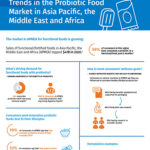Three Meals a Day: The Key to Boosting Digestive Health Markets?

The traditional pattern of breakfast, lunch and dinner may hold the key to boosting digestive health markets, according to the makers of the leading probiotic, BC30™.
A new BC30™ report notes that 85% of consumers say they are interested in buying products with digestive health benefits, but only 45% actually do.1 Additional insights report on key opportunities the three main meal occasions present to tap into this unrealized demand.
For example, the fundamental principle of three meals a day remains resilient, even in the face of the snackification trend. Furthermore, there is demand for probiotics at every meal.
John Quilter, VP & General Manager for Kerry’s ProActive Health Division, the makers of BC30, said: “Breakfast, lunch and dinner – maybe with a few snacks in-between – has been the way billions of humans have eaten for centuries. Mealtimes therefore represent a golden opportunity for food and beverage manufacturers to deliver the many benefits of probiotics and other digestive health ingredients. Aligning innovative products to these specific occasions makes it easy for consumers to incorporate them into their diets.”
The report provides examples of innovative ways of looking at breakfast, lunch and dinner to drive sales of products with digestive health benefits:
Breakfast
Incorporating probiotics into popular breakfast items such as waffles and pancakes taps into demand for nutritious products at the start of the day. They can also help restore the health credentials of cereals – a category that is increasingly demonized for high sugar content. Meanwhile, drinks associated with breakfast are fertile ground for innovation: the number of new hot beverage and juice launches with a probiotic or digestive claim has risen by 22.4% since 2014.2
Lunch
Snacks are a popular choice at lunchtime and enhancing them with probiotics can be a key driver of purchasing decisions. Research among consumers who tend not to buy snacks has found that nearly four in ten would be more likely to do so if they contained probiotics or claimed digestive health benefits.3
Dinner
Prepared evening meals offer excellent opportunities for fortification with probiotics. Certain categories, instant pasta for example, are particularly ripe for innovation. Frozen meals also offer potential, with 23% of consumers saying they would be more likely to buy them if they contained probiotics or claimed digestive health benefits.4
Spore-forming Probiotics
However, many probiotic strains are fragile and need to be refrigerated, making it hard to offer digestive health benefits in products beyond the dairy aisle. Things have changed, thanks to the emergence of hardy spore-forming bacteria that are much more resistant to the extremes of pH, heat, cold and pressure and a better fit for the fortification into everyday products.
The leading spore-forming probiotic is BC30, a patented strain with a protective shell which shields it from stomach acids and most food processing conditions, including heat, shear and HPP pasteurization. This enables manufacturers to integrate probiotics into a wide range of everyday foods and beverages.
Download the full BC30 report, ‘Demand for Probiotics at Every Meal’ here.
Sources
1 GlobalData, Global Consumer Survey Q4, 2015
2 Mintel GNPD, 2019
3 Kerry, SSI Consumer Survey, 2017
4 Kerry, SSI Consumer Survey, 2017


